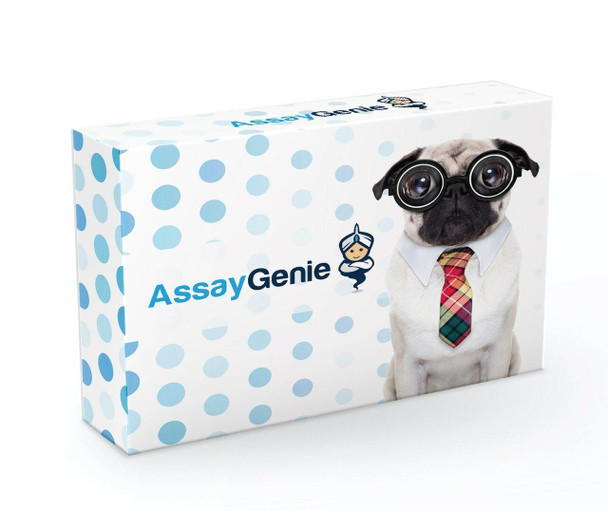Anti-HCK Antibody (CAB14536)
- SKU:
- CAB14536
- Product type:
- Antibody
- Reactivity:
- Human
- Reactivity:
- Mouse
- Reactivity:
- Rat
- Host Species:
- Rabbit
- Isotype:
- IgG
- Antibody Type:
- Polyclonal Antibody
- Research Area:
- Cell Biology
Description
| 抗体名: | Anti-HCK Antibody |
| 抗体コード: | CAB14536 |
| 抗体サイズ: | 20uL, 50uL, 100uL |
| 申し込み: | WB |
| 反応性: | Human, Mouse, Rat |
| 宿主種: | Rabbit |
| 免疫原: | Recombinant fusion protein containing a sequence corresponding to amino acids 324-505 of human HCK (NP_001165600.1). |
| 申し込み: | WB |
| 推奨希釈: | WB 1:500 - 1:2000 |
| 反応性: | Human, Mouse, Rat |
| ポジティブサンプル: |
| 免疫原: | Recombinant fusion protein containing a sequence corresponding to amino acids 324-505 of human HCK (NP_001165600.1). |
| 精製方法: | Affinity purification |
| ストレージバッファ: | Store at -20'C. Avoid freeze / thaw cycles. Buffer: PBS with 0.02% sodium azide, 50% glycerol, pH7.3. |
| アイソタイプ: | IgG |
| 順序: | LKSD EGSK QPLP KLID FSAQ IAEG MAFI EQRN YIHR DLRA ANIL VSAS LVCK IADF GLAR VIED NEYT AREG AKFP IKWT APEA INFG SFTI KSDV WSFG ILLM EIVT YGRI PYPG MSNP EVIR ALER GYRM PRPE NCPE ELYN IMMR CWKN RPEE RPTF EYIQ SVLD DFYT ATES QYQQ QP |
| 遺伝子ID: | 3055 |
| Uniprot: | P08631 |
| セルラーロケーション: | Cell junction, Cell membrane, Cell projection, Cytoplasm, Cytoplasmic vesicle, Golgi apparatus, Lipid-anchor, Lysosome, Membrane, Nucleus, caveola, cytoskeleton, cytosol, cytosol, focal adhesion, podosome membrane, secretory vesicle |
| 計算された分子量: | 57kDa/59kDa |
| 観察された分子量: | Refer to Figures |
| 同義語: | HCK, JTK9, p59Hck, p61Hck |
| バックグラウンド: | The protein encoded by this gene is a member of the Src family of tyrosine kinases. This protein is primarily hemopoietic, particularly in cells of the myeloid and B-lymphoid lineages. It may help couple the Fc receptor to the activation of the respiratory burst. In addition, it may play a role in neutrophil migration and in the degranulation of neutrophils. Multiple isoforms with different subcellular distributions are produced due to both alternative splicing and the use of alternative translation initiation codons, including a non-AUG (CUG) codon. |
| UniProt Protein Function: | Hck: a protein-tyrosine kinase of the Src family that is predominantly expressed in hemopoietic cell types. The encoded protein may help couple the Fc receptor to the activation of the respiratory burst. In addition, it may play a role in neutrophil migration and in the degranulation of neutrophils. Alternate translation initiation site usage, including a non-AUG (CUG) codon, results in the production of two different isoforms that have different subcellular localization. |
| UniProt Protein Details: | Protein type:Oncoprotein; EC 2.7.10.2; Protein kinase, TK; Kinase, protein; Protein kinase, tyrosine (non-receptor); TK group; Src family Chromosomal Location of Human Ortholog: 20q11-q12 Cellular Component: Golgi apparatus; transport vesicle; extrinsic to internal side of plasma membrane; cell projection; focal adhesion; lysosome; actin filament; caveola; nucleus; cytosol Molecular Function:protein binding; protein-tyrosine kinase activity; non-membrane spanning protein tyrosine kinase activity; ATP binding; receptor binding Biological Process: integrin-mediated signaling pathway; respiratory burst after phagocytosis; peptidyl-tyrosine phosphorylation; viral reproduction; protein amino acid autophosphorylation; cytokine and chemokine mediated signaling pathway; regulation of phagocytosis; protein amino acid phosphorylation; regulation of defense response to virus by virus; regulation of cell shape; leukocyte migration during immune response; positive regulation of actin filament polymerization; regulation of transcription factor activity; leukocyte degranulation; positive regulation of cell proliferation; regulation of inflammatory response; lipopolysaccharide-mediated signaling pathway; innate immune response; mesoderm development; cell differentiation; inflammatory response; innate immune response-activating signal transduction; cell adhesion; transmembrane receptor protein tyrosine kinase signaling pathway; negative regulation of apoptosis |
| NCBI Summary: | The protein encoded by this gene is a member of the Src family of tyrosine kinases. This protein is primarily hemopoietic, particularly in cells of the myeloid and B-lymphoid lineages. It may help couple the Fc receptor to the activation of the respiratory burst. In addition, it may play a role in neutrophil migration and in the degranulation of neutrophils. Multiple isoforms with different subcellular distributions are produced due to both alternative splicing and the use of alternative translation initiation codons, including a non-AUG (CUG) codon. [provided by RefSeq, Feb 2010] |
| UniProt Code: | P08631 |
| NCBI GenInfo Identifier: | 20141296 |
| NCBI Gene ID: | 3055 |
| NCBI Accession: | P08631.5 |
| UniProt Secondary Accession: | P08631,Q29RX1, Q2VPE2, Q504R5, Q5T7K1, Q5T7K2, Q96CC0 Q9H5Y5, Q9NUA4, A8K1I1, B4DQB6, E1P5M2, |
| UniProt Related Accession: | P08631 |
| Molecular Weight: | 526 |
| NCBI Full Name: | Tyrosine-protein kinase HCK |
| NCBI Synonym Full Names: | HCK proto-oncogene, Src family tyrosine kinase |
| NCBI Official Symbol: | HCK |
| NCBI Official Synonym Symbols: | JTK9; p59Hck; p61Hck |
| NCBI Protein Information: | tyrosine-protein kinase HCK; p59-HCK/p60-HCK; hemopoietic cell kinase; hematopoietic cell kinase |
| UniProt Protein Name: | Tyrosine-protein kinase HCK |
| UniProt Synonym Protein Names: | Hematopoietic cell kinase; Hemopoietic cell kinase; p59-HCK/p60-HCK; p59Hck; p61Hck |
| Protein Family: | Tyrosine-protein kinase |
| UniProt Gene Name: | HCK |
| UniProt Entry Name: | HCK_HUMAN |

